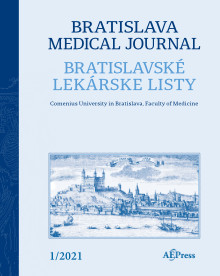Journal info
|
||||
Select Journal
Journals
Bratislava Medical Journal 2024 2023 2022 2021 2020 2019 2018 2017 2016 2015 2014 2013 2012 Ekologia - Ecology Endocrine Regulations General Physiology and Biophysics Neoplasma Acta Virologica Studia Psychologica Cardiology Letters Psychológia a patopsych. dieťaťa Kovove Materialy-Metallic Materials Slovenská hudba 2025Webshop Cart
Your Cart is currently empty.
Info: Your browser does not accept cookies. To put products into your cart and purchase them you need to enable cookies.
Bratislava Medical Journal Vol.120, No.1, p.70–77, 2019 |
||
| Title: Is there a new pathway relationship between melatonin and FEZ1 in experimental rat model of Alzheimer’s disease? | ||
| Author: M. Demir, U. Yilmaz, C. Colak, Y. Cigremis, F. Ozyalin, I. Tekedereli, S. Sandal | ||
| Abstract: Alzheimer’s disease (AD) is a progressive neurodegenerative disease. This study was performed to determine the possible relationship between melatonin, which is known to play a role in the neuro-protective mechanism in AD, and fasciculation and elongation protein zeta 1 (FEZ1). Thirty male rats were included and separated into 3 groups (n = 10) as vehicle (artificial cerebrospinal fluid), streptozotocin (STZ) and STZ+melatonin (MLT). Two intracerebroventricular (icv) injections of 3 mg/kg STZ were made 48 hours apart. MLT injections were implemented for 14 days (ip; 10mg/kg/day). The Morris Water Maze (MWM) test was performed and rats were sacrificed to assess FEZ1 gene expression and protein levels from the hippocampus tissues and serum levels of noradrenaline (NA), dopamine and serotonin were determined from the blood samples. It was determined that the FEZ1/β-actin protein ratio in the STZ group was significantly higher than that of the Vehicle group (p < 0.05) and in the MLT‑administered group, the protein levels were decreased to the levels observed in the Vehicle group. Serum NA levels of STZ and STZ+MLT groups were found to be lower than those in the Vehicle group, while no difference was found regarding dopamine and serotonin levels. These findings show that reversal of increased FEZ1 levels in AD-induced rats with melatonin administration is the evidence of the effect of melatonin through FEZ1 in AD (Tab. 2, Fig. 5, Ref. 67). |
||
| Keywords: FEZ1, Alzheimer’s disease, melatonin, rat, microtubules, mitochondria | ||
| Published online: 22-Jan-2019 | ||
| Year: 2019, Volume: 120, Issue: 1 | Page From: 70, Page To: 77 | |
| doi:10.4149/BLL_2019_011 |
||
|
|
 download file download file |
|

